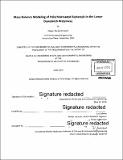Mass balance modeling of polychlorinated biphenyls in the Lower Duwamish Waterway
Author(s)
Burke, Megan Elizabeth
DownloadFull printable version (9.923Mb)
Other Contributors
Massachusetts Institute of Technology. Department of Civil and Environmental Engineering.
Advisor
Eric Adams.
Terms of use
Metadata
Show full item recordAbstract
Remediation is most effective when a site is properly characterized. The Lower Duwamish Waterway (LDW) in Seattle, Washington is contaminated with polychlorinated biphenyls (PCBs). A zero dimensional mass balance of the 5 mile long waterway, which ends in Elliott Bay, helps to determine the different sources and concentrations of PCBs within the Lower Duwamish Waterway to aid future remedial activities. There are four unknown state variables: freshness, suspended sediment concentration, dissolved phase total PCB concentration, and sorbed phase total PCB concentration. The sole freshness source was the Green River and the freshness sink was the flushing at the downstream mouth. PCBs exist in sorbed and freely dissolved phases. Sorbed PCB sources include: the incoming Green River, laterals, and erosion. Sinks of sorbed PCBs include: deposition, flushing, and desorption. The Green River, laterals, diffusion, and desorption are all dissolved PCB sources, while the sinks are flushing and volatilization to the atmosphere. The calculated four state variables were compared to measured values and a sensitivity analysis was performed on the sources.
Description
Thesis: M. Eng., Massachusetts Institute of Technology, Department of Civil and Environmental Engineering, 2016. Cataloged from PDF version of thesis. Includes bibliographical references (pages 30-31).
Date issued
2016Department
Massachusetts Institute of Technology. Department of Civil and Environmental EngineeringPublisher
Massachusetts Institute of Technology
Keywords
Civil and Environmental Engineering.